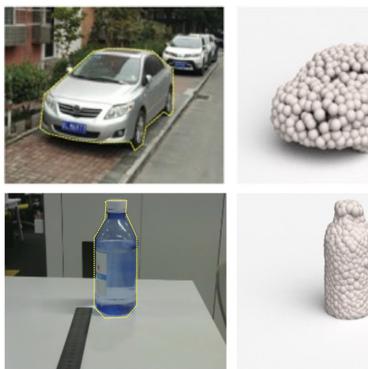Search Results for author: Maxim Tatarchenko
Found 10 papers, 5 papers with code
Learning to Generate Chairs, Tables and Cars with Convolutional Networks
2 code implementations • 21 Nov 2014 • Alexey Dosovitskiy, Jost Tobias Springenberg, Maxim Tatarchenko, Thomas Brox
We train generative 'up-convolutional' neural networks which are able to generate images of objects given object style, viewpoint, and color.
Multi-view 3D Models from Single Images with a Convolutional Network
no code implementations • 20 Nov 2015 • Maxim Tatarchenko, Alexey Dosovitskiy, Thomas Brox
We present a convolutional network capable of inferring a 3D representation of a previously unseen object given a single image of this object.
Octree Generating Networks: Efficient Convolutional Architectures for High-resolution 3D Outputs
1 code implementation • ICCV 2017 • Maxim Tatarchenko, Alexey Dosovitskiy, Thomas Brox
We present a deep convolutional decoder architecture that can generate volumetric 3D outputs in a compute- and memory-efficient manner by using an octree representation.
 Ranked #3 on
3D Reconstruction
on Data3D−R2N2
Ranked #3 on
3D Reconstruction
on Data3D−R2N2
Tangent Convolutions for Dense Prediction in 3D
1 code implementation • CVPR 2018 • Maxim Tatarchenko, Jaesik Park, Vladlen Koltun, Qian-Yi Zhou
Our approach is based on tangent convolutions - a new construction for convolutional networks on 3D data.
 Ranked #2 on
Semantic Segmentation
on S3DIS Area5
(Number of params metric)
Ranked #2 on
Semantic Segmentation
on S3DIS Area5
(Number of params metric)
What Do Single-view 3D Reconstruction Networks Learn?
no code implementations • CVPR 2019 • Maxim Tatarchenko, Stephan R. Richter, René Ranftl, Zhuwen Li, Vladlen Koltun, Thomas Brox
Convolutional networks for single-view object reconstruction have shown impressive performance and have become a popular subject of research.
 Ranked #1 on
3D Reconstruction
on 300W
Ranked #1 on
3D Reconstruction
on 300W
Semi-Supervised Semantic Segmentation with High- and Low-level Consistency
1 code implementation • 15 Aug 2019 • Sudhanshu Mittal, Maxim Tatarchenko, Thomas Brox
The ability to understand visual information from limited labeled data is an important aspect of machine learning.
Self-supervised 3D Shape and Viewpoint Estimation from Single Images for Robotics
1 code implementation • 17 Oct 2019 • Oier Mees, Maxim Tatarchenko, Thomas Brox, Wolfram Burgard
We present a convolutional neural network for joint 3D shape prediction and viewpoint estimation from a single input image.
 3D Object Reconstruction From A Single Image
3D Object Reconstruction From A Single Image
 3D Reconstruction
+3
3D Reconstruction
+3
Parting with Illusions about Deep Active Learning
no code implementations • 11 Dec 2019 • Sudhanshu Mittal, Maxim Tatarchenko, Özgün Çiçek, Thomas Brox
Active learning aims to reduce the high labeling cost involved in training machine learning models on large datasets by efficiently labeling only the most informative samples.
Fostering Generalization in Single-view 3D Reconstruction by Learning a Hierarchy of Local and Global Shape Priors
no code implementations • CVPR 2021 • Jan Bechtold, Maxim Tatarchenko, Volker Fischer, Thomas Brox
Single-view 3D object reconstruction has seen much progress, yet methods still struggle generalizing to novel shapes unseen during training.
Histogram-based Deep Learning for Automotive Radar
no code implementations • 6 Mar 2023 • Maxim Tatarchenko, Kilian Rambach
Compared to existing methods, the design of our approach is extremely simple: it boils down to computing a point cloud histogram and passing it through a multi-layer perceptron.






